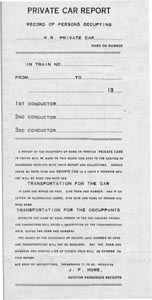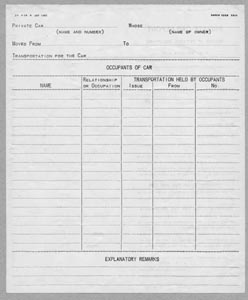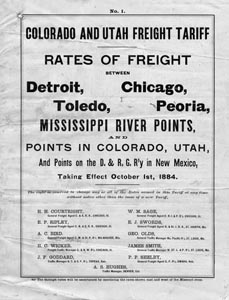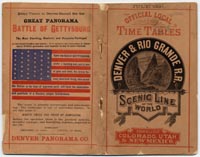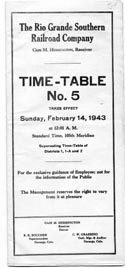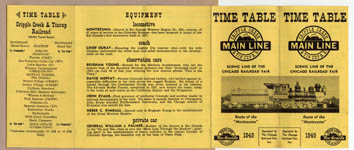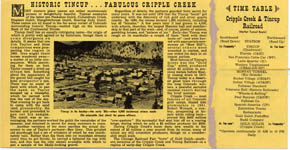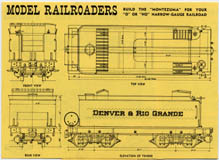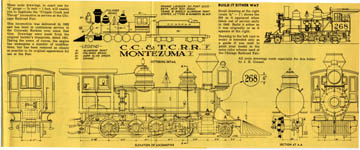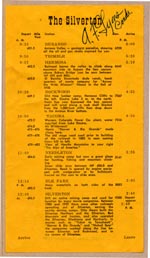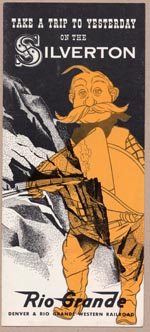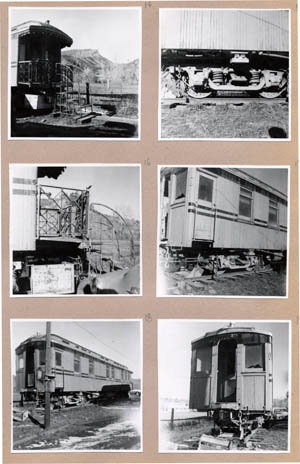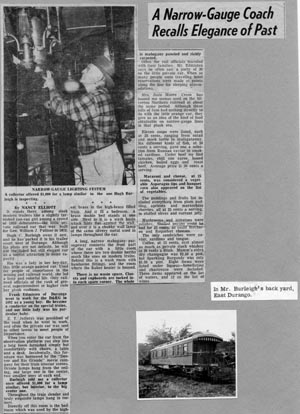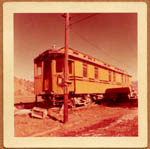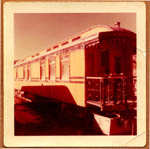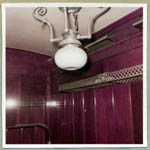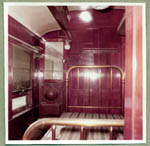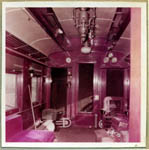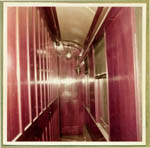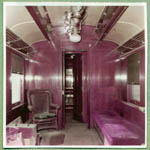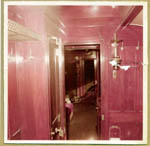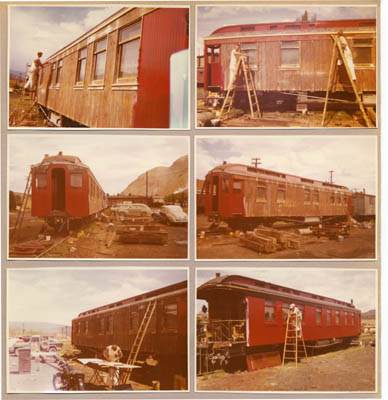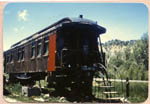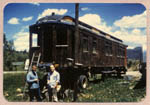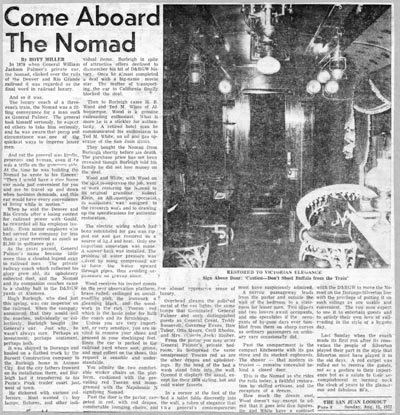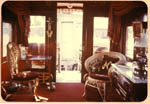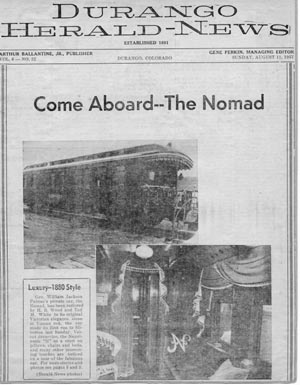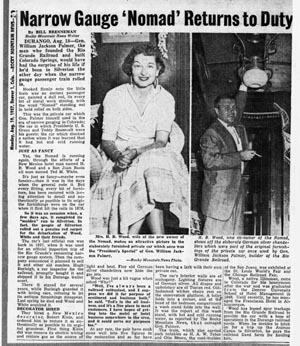Collection
M 019: |
Years this material was created: 1899-1957.
Digital images created: March 2003.
Quantity: portions
of one scrapbook in Series 5.15
© 2003 by Fort
Lewis College Foundation, Center of Southwest Studies account
Links to contents
History of the Nomad
This specially restored car now makes its home in Durango, Colorado, as part of the Durango Silverton Narrow Gauge Railroad. The Center's documentation of the car and its restoration in Durango, depicted on this page in digital images, is primarily drawn from a scrapbook that was found with the RGS collection. Historically, this narrow-gauge VIP business passenger car actually pertained to the Denver & Rio Grande Railroad rather than the Rio Grande Southern: the Nomad was never part of the RGS.
| Built:1878 | Length: 50 feet | Original color: Tuscan Red |
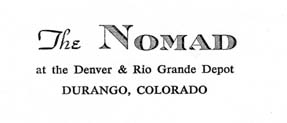 |
| Weight: 25 tons | Width: 8 feet | Builders: Barney and Smith |
Colorado railroad pioneer General William Jackson Palmer, in a letter dated January 17, 1870 to his fiancée Queen (that was her given name, not a title) Mellen (daughter of William P. Mellen, a New York attorney who had been a partner of U.S. Treasury Secretary Salmon P. Chase ), described his vision for building "a little railroad a few hundred miles in length, all under one's control with one's friends," and "`I would have a nice house-car made, just convenient for you and me … to travel up and down when business demanded, and this car would contain every convenience of living while in motion.'" {Cited in General Wm. Jackson Palmer (1836-1909) and the D.& R.G.W. Railroad!, by Judge Wilson McCarthy, (New York: The Newcomen Society in North America, 1954), p. 18.}
General Palmer (a veteran of the U.S. Civil War) founded the Denver and Rio Grande Railroad (D.& R.G.) in 1870. The car that he had envisioned was built in 1878: it was Private Car 3, the rear car (it became known as the Nomad) of a three-car train called the President's Special. The middle car consisted mainly of berths (two upper, two lower); the first car held the kitchen and bunks for the crew. General Palmer retained the exclusive use of the Nomad during its first years.
This car was involved in the competition of the pioneering railway construction days. As Lucius Beebe writes, "Two narrow gauge railroads, the Rio Grande and the South Park, raced for Leadville when that carbonate citadel was at the heights of its boom. The Rio Grande, which was already in operation up the canyon of the Arkansas [River], got there first by the simple expedient of building a five-mile branch connecting with the main line at Malta. Aboard the first train to reach Leadville as guest of General Palmer and his private car Nomad was ex-president [General Ulysses S.] Grant, then returning from a trip around the world. Twelve brass bands, each playing a different tune at the same time, were on the depot platform, and chairman of the reception committee was the Lt. Governor of Colorado and architect of Leadville' s florid destinies, Horace A. Tabor. It was Leadville' s banner day, and so great was Tabor's personal triumph that by evening he was uncommonly drunk -- even by Leadville standards, which were liberal." {Hear the train blow; a pictorial epic of America in the railroad age, by Lucius Beebe and Charles Clegg (New York, Dutton 1952).}
The car was the epitome of luxury. "When, in the mid-1870s, the Denver, Colorado Rocky Mountain News reported that there was both hot and cold running water aboard the Nomad, the narrow gauge private car of General William Jackson Palmer, builder of the Rio Grande Railroad, the old gentleman was outraged. Not only did the discussion of such intimate matters constitute a violation of privacy, it also made him, an old campaigner, out to be a Sybarite and a downright softy'." {"Varnish for the Nabobs," by Lucius Beebe, American Heritage Magazine} The car's original telegraph key -- constructed of mahogany and German silver -- was retained through the car's restorations.
Palmer sold out to financier Jay Gould after a Rio Grande board meeting on June 22, 1883 accused the General of spending too much on unprofitable mountain railroad lines (click to see a map of the routes). Palmer formed a second railroad called the D.& R.G. Western. The 3-car train stayed with the original road -- it was no longer General Palmer's. The special car, known variously as the P.B.&N., the Millionaires' Special, and The President's Special, was always held in reserve for the use of the president of the railroad or for important personages. Among the famous and near famous who have ridden the Nomad are President U. S. Grant, President Theodore (Teddy) Roosevelt, Colorado Governor Evans, Haw Tabor and Baby Doe, Otto Mears, and Cecil Rhodes. Other figures included mining millionaires, European royalty, and political figures of note during the narrow gauge days of Colorado.
This car, with a vestibule at each end, was exhibited at the 1904 World's Fair in St. Louis, where it attracted attention as the first all-steam heated car. As Gilbert Lathrop notes, "During the St. Louis World's Fair, the D.&R.G. exhibited the first all-vestibuled, steam-heated passenger train in the United States. This three-car train was called the P. B. and N. and was built for the railroad president, or for the higher officials. It is unknown how much money this train cost, but from the heavy silver service, the cut glass, the thick all-wool blankets and other fixtures, it must have been a pretty penny. The rear car was for the President. It had a glassed-in observation end with an air gauge and a speed meter as well as front-view mirrors so his nibs could check on the engine crews on the curves. In this car also a stateroom with a full bed, lavatory, etc. Then a kind of council room. The second car had a couple of staterooms and an elaborate kitchen. The head car was for the flunkeys and train crews to ride and it had bunks for use in case the P B & N was caught away from a town. It received much newspaper publicity during the fair, and when it finally returned to service on the narrow gauge it continued to create publicity as well as profanity on the part of the enginemen having to haul it around with a little thirty-ton engine. Those three cars were heavy! It was like a lead tail to a kite to try to hoist them up Marshall Pass, or over Cerro Summit. We finally persuaded the officials that a helper engine would save much delay, and they capitulated." {Little Engines and Big Men, by Gilbert A. Lathrop (Caldwell, Idaho, Caxton Printers, 1954).}
By the time this unique train was exhibited at the 1915 World’s Fair in San Francisco, the rear vestibule had been converted to the open platform as it is today. The three cars were then re-numbered the B1, B11 and B111, and the entire train was known as The President's Special.
The president's special figured in, as it turned out, a fortuitous accident in early 1917. As Josie Crum, writes, "A group of Eastern capitalists, of whom seven were millionaires, made the trip in January of 1917. They were accompanied by mining engineers, clerks, servants and other retainers. At Silverton the snow was deep. It was crisp and cold and everyone was drinking a bit, even the train crew. However, the train left Silverton on time. Just outside Silverton’s town limits, a coupler knuckle snapped on the tender. The train stopped, but the engineer didn’t even notice his loss and went on for a mile or so. When they discovered the train was missing, both the engineer and fireman thought fast. They simply plowed the track into Eureka. On their return, they told everyone that since the snow was so deep they had felt it prudent to go ahead and clear the line first, then come back to the train. The ruse worked, too! The `Special’ laid over at Eureka for about a week. Officials and engineers made a thorough investigation of the Sunnyside mine. A few months later, they purchased the property. On the return trip to Durango behind the Denver and Rio Grande engine 169, the `Million Dollar Special’ was wrecked and two of the three cars were completely destroyed by fire. No one was seriously injured.” {Rails Among the Peaks: three little lines, by Josie Crum (Railroader, 1956).}
The Nomad saw almost continuous use until World War I, but very little after that. It made occasional runs out of Salida, Colorado, which was then Division Headquarters for the D.&R.G. According to articles in Durango and Denver papers, it was displayed at the Century of Progress exhibition in Chicago in 1933. Its last official run was for the purpose of an inspection of the narrow gauge segment of the D.&R.G. in late 1937.
After World War II -- early in 1949 -- the Nomad was brought out of retirement, was painted a yellow ochre color and was renamed The General William Palmer. In this color, it was again shipped to Chicago aboard a broad-gauge flatcar and was placed on the rear of a special narrow gauge train that was exhibited at the Chicago Railroad Fair. As usual, only high-ranking rail officials were allowed to inspect, or ride on, the car.
After its return from Chicago, this time to Alamosa, the Nomad car was sold to Lad Arend of Ohio, who, after a year, sold it to Hugh C. Burleigh, a retired railroad car inspector in Durango. The Burnett Construction Company of Durango shipped the car to Durango on a flatbed truck. The city frowned on Burleigh's installation of the old car in his backyard in Animas City (now north Durango), so he moved it to his Perins Peak Trailer Court just west of Durango, intending to rent it by the night to rail fans. This never materialized, at least in part due to difficulties of installing electricity in the original gas chandeliers.
Soon before Mr. Burleigh died in the spring of 1957, Albuquerque hotelier H. B. Wood and his wife bought the car, in partnership with San Juan Basin oil man Ted M. White -- apparently matching a bid by movie actor Gene Autrey of California and promising Burleigh that they would keep this car on Colorado rails. By this time, after sitting exposed to the elements for over six years, the yellow paint was flaked and was missing in many places. Much of the exterior wood was split and warped. The interior, however, was intact (mostly needing cleaning and restoration) -- the car was complete, down to the silver chandeliers and spittoons. The owners moved the car to the Durango railroad yard and commissioned one of the finest interior designers in the Southwest, a specialist in Gay Nineties decorations, Robert Klein of Albuquerque, New Mexico, to conduct historic research and restore the interior to its original splendor. This included removing the non-authentic electric wiring and restoring gas as the source of light and heat -- and also adding the modern convenience of a shower bath (concealed behind a door).
This restoration was completed in July of 1957, and the Nomad made its maiden run from Durango to Silverton, Colorado, on Sunday, August 4, 1957. According to a story in the Rocky Mountain News that summer, "Wood has leased spur trackage from the Rio Grande Railroad to provide the car with a base of operations in the Durango railroad yards. When he decides to hitch on for a trip up the Animas Canon to Silverton, he pays the railroad fixed fares for hauling him." {"Narrow Gauge `Nomad"' Returns to Duty," by Bill Brenneman, Rocky Mountain News, Aug. 19, 1957, p. 30.}
Today, the Nomad is owned by the Durango & Silverton Narrow Gauge Railroad. The fee to charter the Nomad is $5,000. Rich in history, the Nomad is again active on the rails transporting notables as it did in the early days.
WELCOME ABOARD THE NOMAD!
|
Railroads used the form below to document the movement of passengers in private cars in the early 20th century: |
||
| Diagrams of telegraph wires along the D.&R.G.: The train crew sent telegraphs by laying a special pole against a designated wire and tapping out messages over the system. |
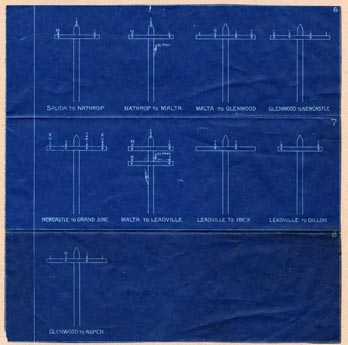 |
|
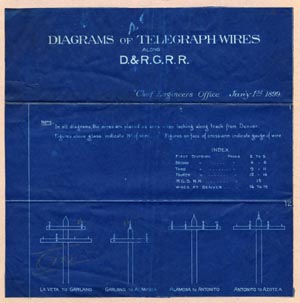 |
||
|
Telegram re: schedule of the 3-car President's Special (including Private Car 3, known as the Nomad), Sept. 13, 1915, with explanatory note by Bob Richardson dated Aug. 29, 1957 to H. B. Wood who restored it in 1957: |
||
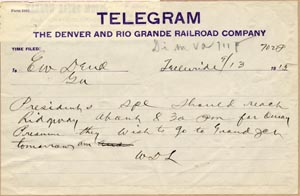 |
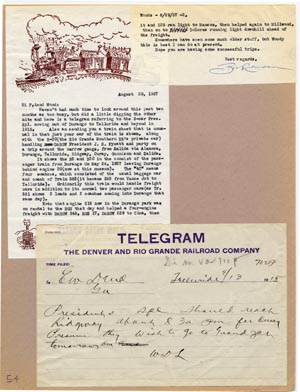 |
|
|
Silverton Northern Railroad items:
Wine list for the
(On far right, from
Collection M 037) |
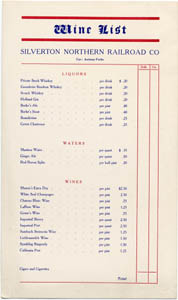 |
 |
 |
||
|
Colorado and Utah freight rates, 1884: |
Denver & Rio Grande Railroad official local timetables, July 1887: |
Rio Grande Southern Railroad |
Timetable used at the Railroad Fair in Chicago in 1949 (click on item for larger image):
Views of the Nomad
| At the time of sale and removal from the railroad, 1951: | Lad G. Arend of Ohio bought the car from the Denver & Rio Grande Western Railroad for $1,500; after a year, he sold it to Hugh C. Burleigh | |
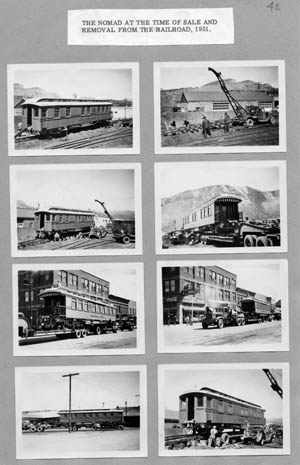 |
 |
Durango - Silverton Railroad schedule, ca. 1970s, autographed by the conductor, A. F. Lyons: |
|
In Hugh C. Burleigh's lot adjacent to the La Plata County Fairgrounds in north Durango, 1951: |
Cover of the schedule for riding the narrow-gauge train to Silverton, ca. 1970s: |
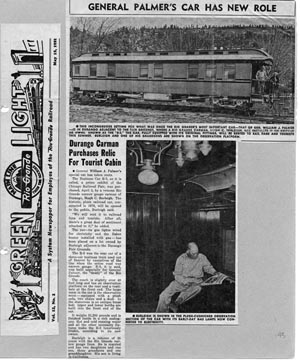 |
| In Mr. Burleigh's back yard at 2802 E 2nd Avenue in east Durango, early 1950s: | ||
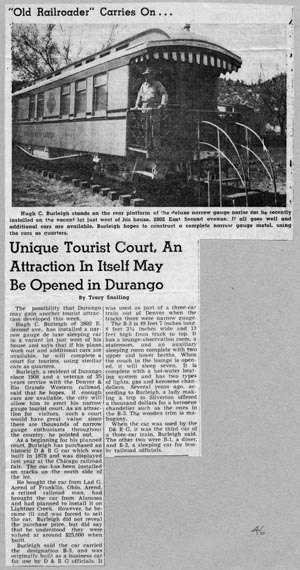 |
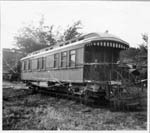 |
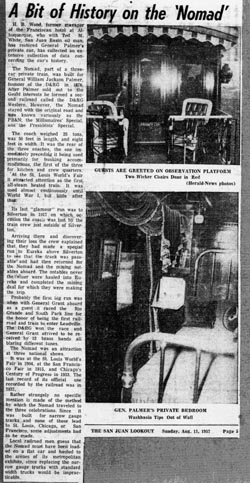 |
At Perins Peak Trailer Court, early-to-mid-1950s, when owned by Mr. Burleigh:
As seen during the winter of 1956: The wall paneling is of mahogany. The upholstery is of Tuscan red. A toilet folds into a corner, and a wash stand folds into the wall at the head of the bedroom compartment.
During restoration in the mid-1950s by H. B. Wood and Ted M. White:
Being moved back to the rails in June of 1957:
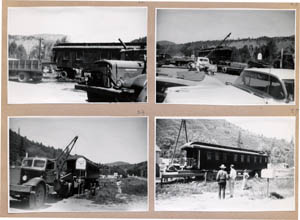 |
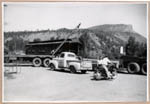 |
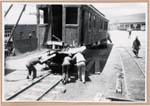 |
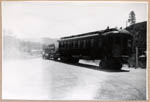 |
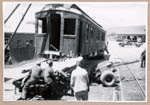 |
After restoration that was completed in July of 1957: The letter of October 14th notes that final expenses amounted to some $13,500, rather than the $8,370 that was budgeted. Interior designer Robert L. Klein decorated the interior in a Victorian style, with velvet draperies. The Napoleonic "N" (for Nomad) was the crest on the pillows, chairs, and beds.
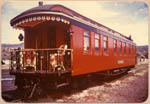 |
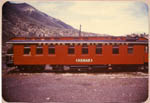 |
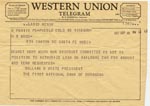 |
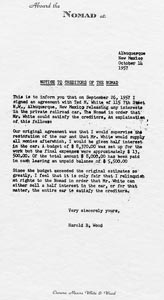 |
|
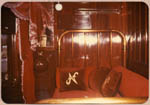 |
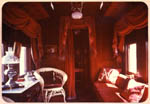 |
|||
| Newspaper publicity about the Nomad on its maiden runs between Silverton and Durango in the summer of 1957: | ||||
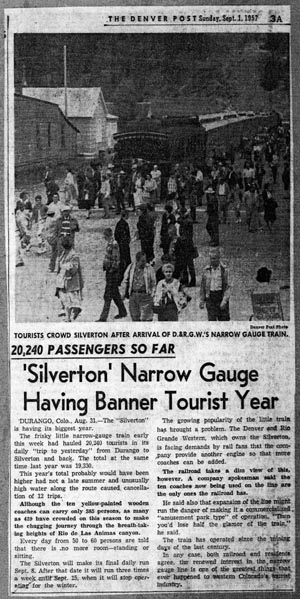 |
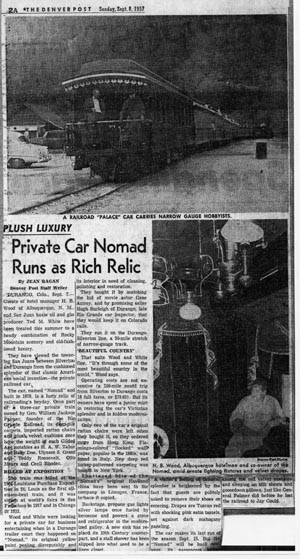 |
|||
For further reading:
Collman, Russ. The R.G.S. story : Rio Grande Southern. Denver, Colo.: Sundance Publications Limited, 1990-. 9 volumes. LC call number: HE2791.R6415 C6 (Oversize). A copy of each is available for use in the Delaney Library at Fort Lewis College.
Crum, Josie Moore. The Rio Grande Southern story. Durango, Colo.: Railroadiana, 1957. LC call number: HE2791.R6415 C7 1957 (Oversize). A copy is available for use in the Delaney Library; a second copy is available for checkout from the Reed Library -- both at Fort Lewis College.
Ferrell, Mallory Hope. Silver San Juan: the Rio Grande Southern Railroad. Boulder, Colo.: Pruett Pub. Co., 1973. LC call number: HE2791.R635 F47 (Oversize). A copy is available for use in the Delaney Library; a second copy is available for checkout from the Reed Library -- both at Fort Lewis College.
© 2003 Center of Southwest Studies, Fort Lewis College. All rights reserved (click here for Property Rights Statement).
1000 Rim Dr., Durango, CO 81301-3999 ~ Phone 970-247-7126 ~ Fax 970-247-7422
This guide was produced by Todd Ellison, Certified Archivist, Center of Southwest Studies; last revised May 16, 2007.
Doing your own research:
This description of a portion of the collections at the Fort Lewis College Center of Southwest Studies is provided to inform interested parties about the nature and depth of the repository's collections. It cannot serve as a substitute for a visit to the repository for those with substantial research interests in the collections.
These collections are located at the Center of Southwest Studies on the campus of Fort Lewis College. Interested researchers should phone the archivist at 970/247-7126 or send electronic mail to the archivist at: archives@fortlewis.edu. Click here to use our E-mail Reference Request Form. The Center does not have a budget for outgoing long-distance phone calls to answer reference requests, so please leave an email address if you wish to receive a response from us.

